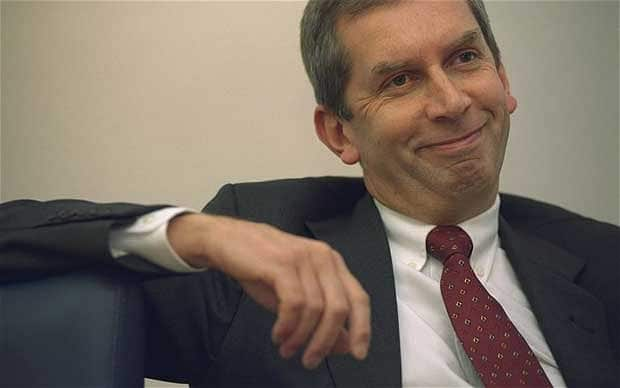Terry Smith has emerged as Britain’s top investment performer once again after another year of stellar returns – while Neil Woodford languishes at the bottom of the tables after his worst year on the stock market for two decades.
When Smith launched Fundsmith Equity in November 2010 he boldly promised it would be “the best fund ever”, and would give the “fat and complacent” fund management industry a bloody nose. It sounded like bluster and bravado, but he was true to his word. In 2017, Fundsmith Equity gave its investors a gain of just over 22% – easily outstripping the 10% investors would pick up from an index-tracking fund in the UK, or 12% from US trackers, where most of Fundsmith Equity’s money is invested.
Someone who put £1,000 in Fundsmith Equity at launch in 2010 has enjoyed a remarkable total gain of 264%.
Around 60% of Fundsmith Equity is in US shares, and the pound’s fall against the dollar has helped turbo-charge returns. But its biggest holding is Madrid-based Amadeus, which provides booking and pricing for airlines, and its shares have soared from €43 (£38) to €61 over the last year. Smith’s second largest holding, PayPal, has performed even better, rising from $40 (£29.90) a share in January to $74 in the last few days.
A look at the UK’s biggest funds that are popular with small investors shows Fundsmith Equity, now managing £13.3bn, topped the table in 2017, followed by Stewart Investors Asia Pacific Leaders, with a gain of 12.3%. But a disappointing picture of underperformance emerged with many other of the big funds, with most failing to beat or even match the FTSE or the S&P 500. The two biggest laggards are Standard Life’s Global Absolute Return Strategies (GARS), and Woodford Equity Income.
Many thousands of small investors have been put into GARS by financial advisers, with the promise that it would earn a relatively secure 5% a year returns over a rolling three-year period. But this year it only managed to return 1.6%, and last year actually lost 2.7%. Not surprisingly, many investors have been baling out.
Neil Woodford has gathered more than £8bn from his devoted army of small investors – but 2017 was a terrible year for Britain’s best-known fund manager. His portfolio of shares was down just over 1% in 2017 and is ranked a rock-bottom 84th out of 84 funds in the UK equity income sector over one year. He was stung by a crash in the value of Provident Financial, the doorstep lender where he was a big investor. Its shares are down from £29 to less than £9. His tobacco share holdings, which have proved huge moneyspinners in the past, went rather yellow and tar-stained during 2017. Imperial Tobacco, his second-largest holding, was down from £35 a share to £31 a share. Woodford believes a lot of markets are in bubble territory, with bitcoin mania symptomatic of speculative fever.
China turned out to be the best place to put your money in 2017, although the surprise third best place – given the gloom forecasts by some over Brexit – was UK smaller companies.
The average China-invested fund gave a return of 34% in 2017, according to data from FE Trustnet, while Japanese smaller companies earned 25.3% and UK smaller companies 25.1%. Anyone in bonds and gilts saw returns in the zero to 2% range, reflecting historically low interest rates around the world. But what’s surprising is that there was no sector which had negative returns – nearly everything was up in 2017.
Should that make investors wary about 2018? Will it be the year that the long bull-run in equities goes into reverse?
Adrian Lowcock, investment director of Architas, says 2017 “has been a strong year for equity markets. The global economy has been in fairly good health, and we have seen a period of synchronised global growth. However, markets are expensive. In 2018 we expect the phase of synchronised global growth to continue and corporate earnings to continue to grow. However, equity markets are unlikely to have a repeat of 2017.”
At Jupiter, vice-chairman Edward Bonham Carter adds: “It’s all getting a bit pricey … On a forward price-to-earnings ratio, a key measure used to work out whether a share is good value or not, many of the biggest indices, including the FTSE All-Share, the S&P 500 and the MSCI Emerging Markets Index, are all trading close to their historic highs.”
Schroders chief executive Peter Harrison is more sanguine, saying that while share prices in the US are “stretched”, in both Japan and Europe, stock markets should benefit from rising profit margins.
“Overall, we carry a spirit of cautious optimism into 2018, albeit that caution may start to overwhelm optimism as the year wears on,” he says.
The best sectors of 2017
Sector Annual return (%)
China/Greater China 33.8%
Japanese Smaller Companies 25.3%
UK Smaller Companies 25.1%
Technology & Telecoms 24.9%
European Smaller Companies 23.9%
Asia Pacific Excluding Japan 23.8%
Global Emerging Markets 22.8%
Japan 18.3%
Europe Excluding UK 17.5%
UK All Companies 12.5%
North America 11.1%
UK Equity Income 10.1%
Property 6.6%
Sterling Corporate Bond 4.6%
UK Gilts 0.9%
The best funds of 2017
Fund Annual return (%)
NB China Equity 52.3%
Baillie Gifford Greater China 49.5%
Invesco PRC Equity 47.4%
Old Mutual UK Smaller Companies Focus 46.8%
Polar Capital UK Absolute Equity 46.7%
Barclays Global Access Pacific Rim 45.4%
Matthews Asia China 44.3%
JPM Greater China 42.1%
JPM Asia Growth 41.8%
Janus Henderson China Opportunities 41.8%


